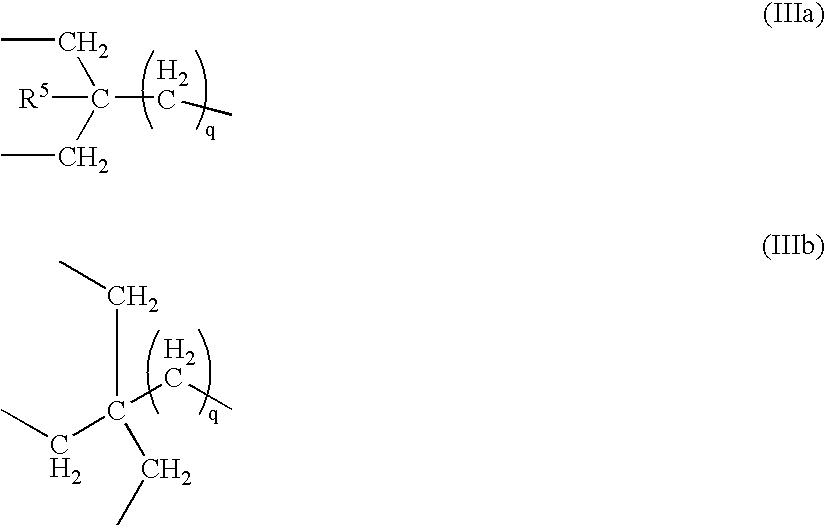Rheology control agents for coating compositions
a technology of rheology control agent and coating composition, which is applied in the direction of synthetic resin layered products, transportation and packaging, coatings, etc., can solve the problems of rheology control, pigments or special effect pigments, flake control and proper flake orientation, etc., and achieve the effect of improving rheology control
- Summary
- Abstract
- Description
- Claims
- Application Information
AI Technical Summary
Benefits of technology
Problems solved by technology
Method used
Image
Examples
example 1
[0145] The following show the preparation of rheology control agents:
General Preparation Procedure for Compounds Having Above Formulas (IV)-(XVI):
[0146] The aminoalcohol (4.16 mol) and chloroform (800g) were charged into a 2 L flask, under N2 protection. The diisocyanate (0.42 mol) was added over 2 hours at 0° C. into the flask with vigorous stirring, followed by continued stirring at RT (room temperature) for 2 hours. In most cases the precipitation of a white solid was observed. The solid was purified through repeated filtration using acetonitrile as a wash solvent. In cases without solid precipitation addition of acetonitrile resulted in solid precipitation. The solid was dried under vacuum overnight at RT. In general LC / MS (Liquid Chromatography / Mass Spectroscopy) result showed purity of >94% with small amounts of higher molecular weight impurities.
[0147] Under N2 protection, the isolated white solid (0.26 mol) was added into a 1000 ml flask followed by 500 g of N-methylpyrr...
example 2
Evaluation of Rheology Control Agents in Coating Compositions
[0162] The above prepared rheology control agents were tested for rheological activity in a liquid organic resin coating composition. A high Tg acrylic resin (A), a hyperbranched polyester resin (B), and a low M.W. polyester resin (C) were used to evaluate these reagents. The organic resin systems were combined with 1-4% of the rheology control agent and diluted with an indicated amount of solvent. After mixing vigorously, the mixture was checked for gelation / viscosity increase after certain times by inverting the container. The scale of the rheology activity testing is based on a rating scale from 1-5:1=the content will flow immediately, viscosity is the same as paint resin, 2=the content will flow immediately, but viscosity is higher than paint resin, 3=the content will flow between 2 to 10 seconds, 4=the content will flow after 10 seconds, 5=mixture is not flowing at all. The results are shown in the following Table ...
example 3
[0169] The following lacquer base coating composition was prepared:
Pigment Dispersion #1 Preparation:
Add the Following in Order with Mixing: Grams
[0170] Highly Branched Copolyester Polyol* 58.68 [0171] Methyl Amyl ketone 138.38
Add slowly with mixing at high speed (approximately 5000 RPM ) on a lab top high speed disperser using a blade with a diameter of approximately 6 cm.
[0172] Rheology control agent 17.5 —Structure X (16.8% in NMP With 3% LiCl)
Mix at high speed (approximately 5000 RPM) on a lab top high speed disperser, using a blade with a diameter of approximately 6 cm, for 30 minutes.
[0173] *Same composition as Solution 5 of WO 03 / 070843 but made in methyl amyl ketone as the solvent vs. propylene glycol monomethyl ether acetate.
[0174] Base Coating Composition Preparation:
Solvent Blend AComponentGramsAcetone162Isobutyl alcohol234Isopropanol180Methyl isobutyl ketone108Aliphatic hydrocarbon (bp = 90 − 110 C.)270Xylene216Aromatic hydrocarbon (bp = 150 − 190 C.)18Tota...
PUM
| Property | Measurement | Unit |
|---|---|---|
| Percent by mass | aaaaa | aaaaa |
| Percent by mass | aaaaa | aaaaa |
| Percent by mass | aaaaa | aaaaa |
Abstract
Description
Claims
Application Information
 Login to View More
Login to View More - R&D
- Intellectual Property
- Life Sciences
- Materials
- Tech Scout
- Unparalleled Data Quality
- Higher Quality Content
- 60% Fewer Hallucinations
Browse by: Latest US Patents, China's latest patents, Technical Efficacy Thesaurus, Application Domain, Technology Topic, Popular Technical Reports.
© 2025 PatSnap. All rights reserved.Legal|Privacy policy|Modern Slavery Act Transparency Statement|Sitemap|About US| Contact US: help@patsnap.com



